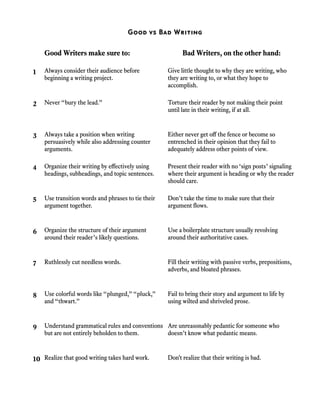Good writers vs bad writers
- 1. Good vs Bad Writing Good Writers make sure to: Bad Writers, on the other hand: 1 Always consider their audience before beginning a writing project. Give little thought to why they are writing, who they are writing to, or what they hope to accomplish. 2 Never ŌĆ£bury the lead.ŌĆØ Torture their reader by not making their point until late in their writing, if at all. 3 Always take a position when writing persuasively while also addressing counter arguments. Either never get o’¼Ć the fence or become so entrenched in their opinion that they fail to adequately address other points of view. 4 Organize their writing by e’¼Ćectively using headings, subheadings, and topic sentences. Present their reader with no ŌĆśsign postsŌĆÖ signaling where their argument is heading or why the reader should care. 5 Use transition words and phrases to tie their argument together. DonŌĆÖt take the time to make sure that their argument ’¼éows. 6 Organize the structure of their argument around their readerŌĆÖs likely questions. Use a boilerplate structure usually revolving around their authoritative cases. 7 Ruthlessly cut needless words. Fill their writing with passive verbs, prepositions, adverbs, and bloated phrases. 8 Use colorful words like ŌĆ£plunged,ŌĆØŌĆ£pluck,ŌĆØ and ŌĆ£thwart.ŌĆØ Fail to bring their story and argument to life by using wilted and shriveled prose. 9 Understand grammatical rules and conventions but are not entirely beholden to them. Are unreasonably pedantic for someone who doesnŌĆÖt know what pedantic means. 10 Realize that good writing takes hard work. Don't realize that their writing is bad.

